Testing is an integral part of product launches.
It doesn’t matter if you’re producing machinery, media, or software—one way or another, you should probably test whatever you’re selling before you present it to the client.
Furthermore, to ensure that the testing is as thorough, detailed, and effective as possible, it’s a good idea to have a software documentation base.
In this article, we’ll explain what exactly testing documentation entails, highlight its importance, and list some types of testing that exist. Towards the end, you’ll also get some helpful tips.
By the time you finish reading, you’ll be an expert in software testing documentation.
What Is Software Testing Documentation?
Software testing documentation describes artifacts created before and during software testing. In other words, it’s a record of the testing team’s strategy, objectives, processes, metrics, and results.
Here's a quick read recommendation before you continue the article. We spoke about various types of software documentation to know about.
The below graph shows some testing documentation examples (outlined in red) and when they occur in the software testing life cycle.
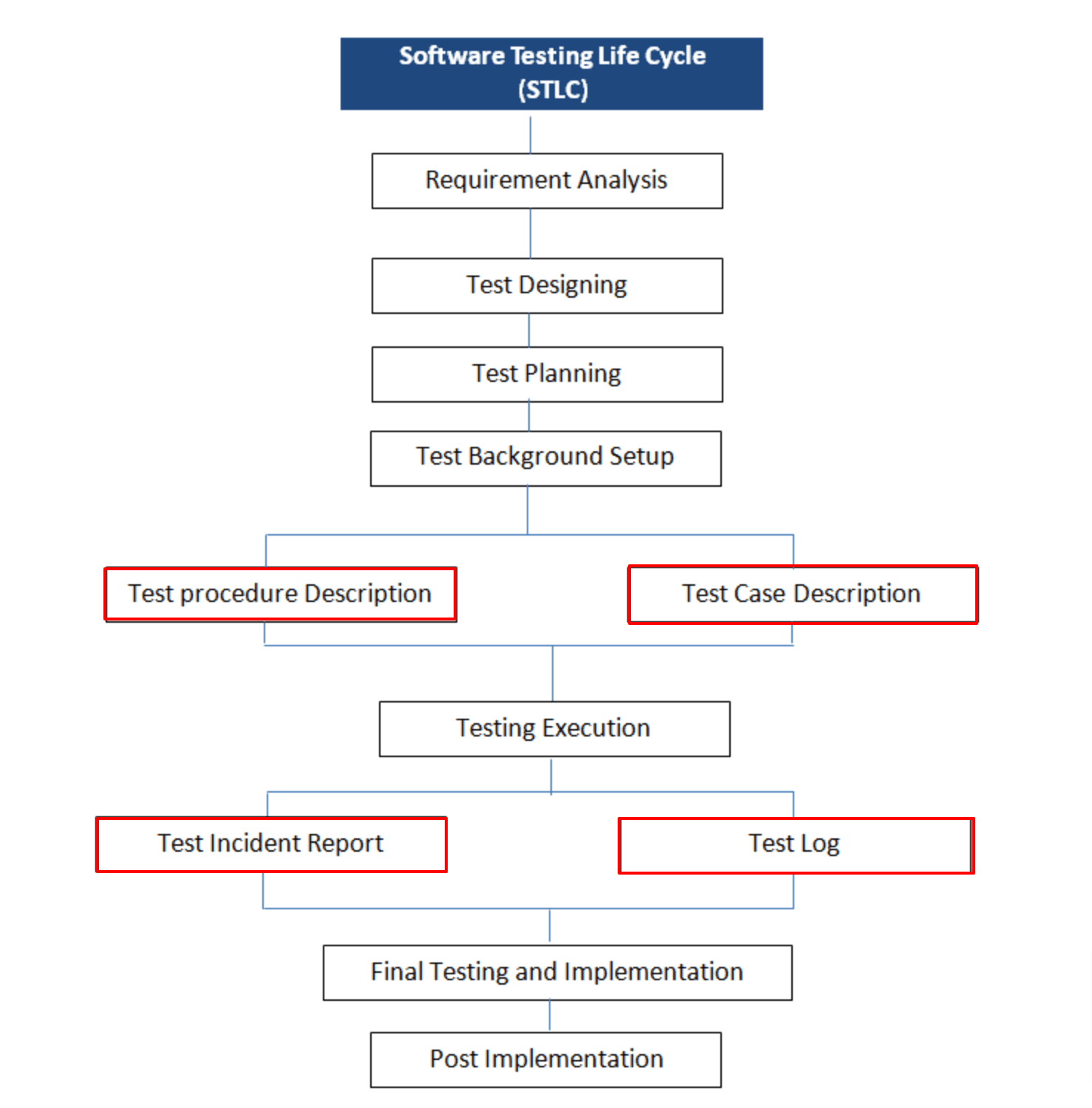
Source: Software Testing Class
These are only some types of testing documentation—an exhaustive list will be provided later. Nevertheless, the visual gives a general overview.
Software testing is a formal component of software development and shouldn’t be just briefly documented.
After all, the documentation facilitates and authenticates test planning, reviewing, and deployment.
However, the formality level depends on your company’s regular practices, development maturity level, and the software type being tested.
Why Is Testing Documentation Important?
It’s worth documenting your testing processes throughout, as doing so brings many benefits. However, the main advantage of testing documentation is the detailed analysis it entails.
By chronicling software testing, you’ll have a clear overview of the entire process and can pinpoint both efficiency blockers and boosters.
After recognizing the pain points, new approaches can be implemented to increase productivity. The constant monitoring helps continuously improve testing.
Tom DeMarco famously commented on this:

Source: Archbee.com
By measuring testing practices, teams can better manage those practices. For example, if KPIs aren’t met, it will be easier to uncover why with testing documentation.
Procedures can then be edited for upcoming, improved endeavors.
Testing documentation is also invaluable financially. Imagine if your server wasn’t correctly rendering or routing pages and your website/app wasn’t loading the right displays.
Without testing documentation, hours would be spent resolving the issue, and Marketing would have to perform damage control, causing costs to skyrocket.
However, a quality testing record should detail the reason for the error and offer possible solutions.
This way, testing documentation will help resolve future issues, acting as a reference point.
The below image visualizes the cost of defects throughout software development. If a flaw occurs during the testing stage, there are huge costs.
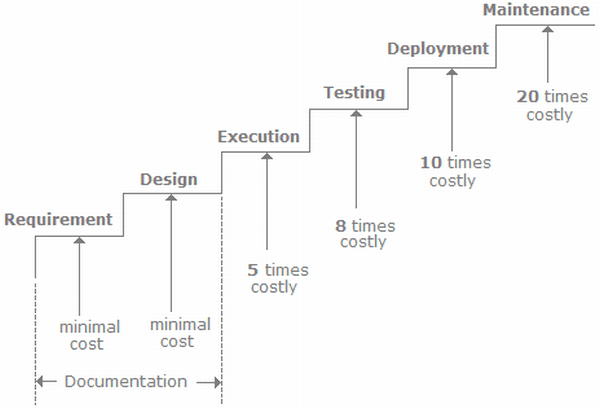
Source: C# Corner
Costs rise as the project advances. As such, it’s imperative to record testing processes correctly and minimize later risks.
Besides economic fallout, testing documentation also helps avoid the occurrence of information silos. It isn’t unusual for developers and QA teams not to know what the other is working on.
However, with testing documentation, visibility is 20/20. Everyone can gain insight into other people’s work as needed, easing collaboration.
Furthermore, having one source of information reduces the chance of miscommunication, as all teams continuously refer to documented processes.
Since all possible specifications are recorded, keeping track of information is easy.
This is especially useful when new hires enter the company, as the documentation can serve as training material.
With so much information recorded, the employee onboarding process is accelerated; you won’t need to assign mentors to new recruits. Instead, just point them to the documented intelligence.
The numbers below show how much time is typically spent on testing:
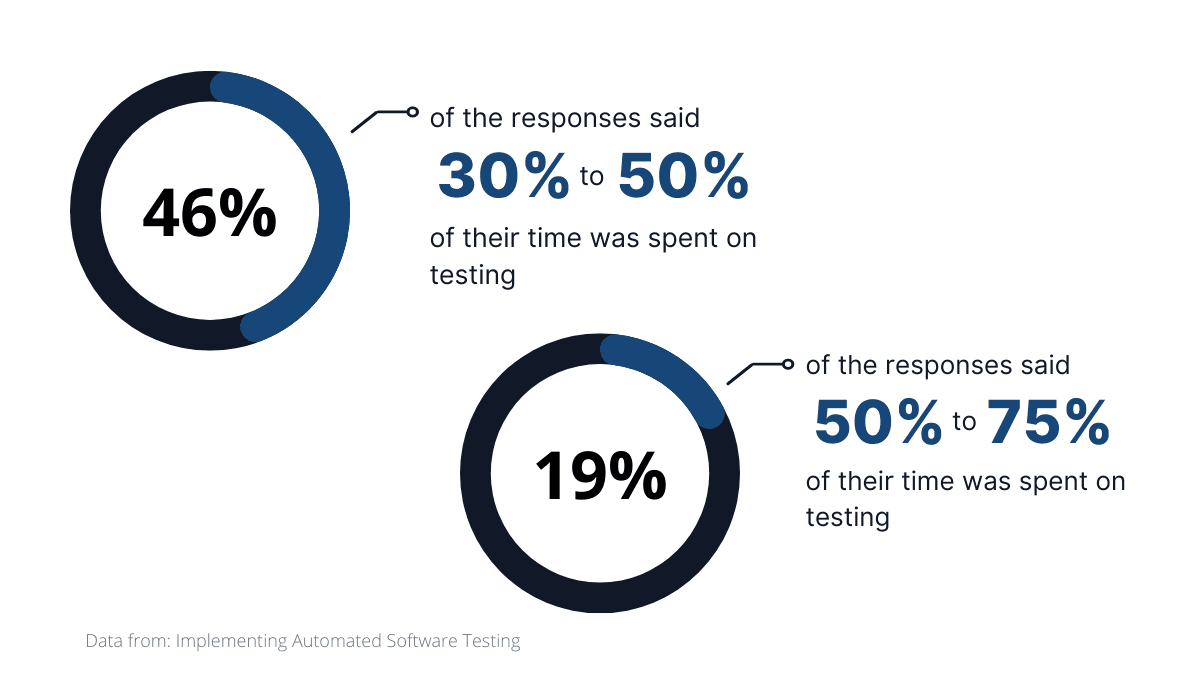
Source: Archbee.com
When all that testing is properly documented, you have a gold mine of information to pass on to new hires.
Test Documentation Types
Software testing documentation caters to two different audiences. First of all, it provides QA teams with definitive data, so they can more easily strategize and perform testing.
Secondly, it communicates testing progress to relevant outside parties such as the Marketing team, the Development team, and, of course, product owners.
As such, testing documentation can be broadly categorized as either internal or external.
Of course, there are various standards and document types; this all depends on the company, product, and customer.
However, generally speaking, the below categorization is most widely used.
Internal Testing Documentation
Internal testing documentation consists of eight principal types:
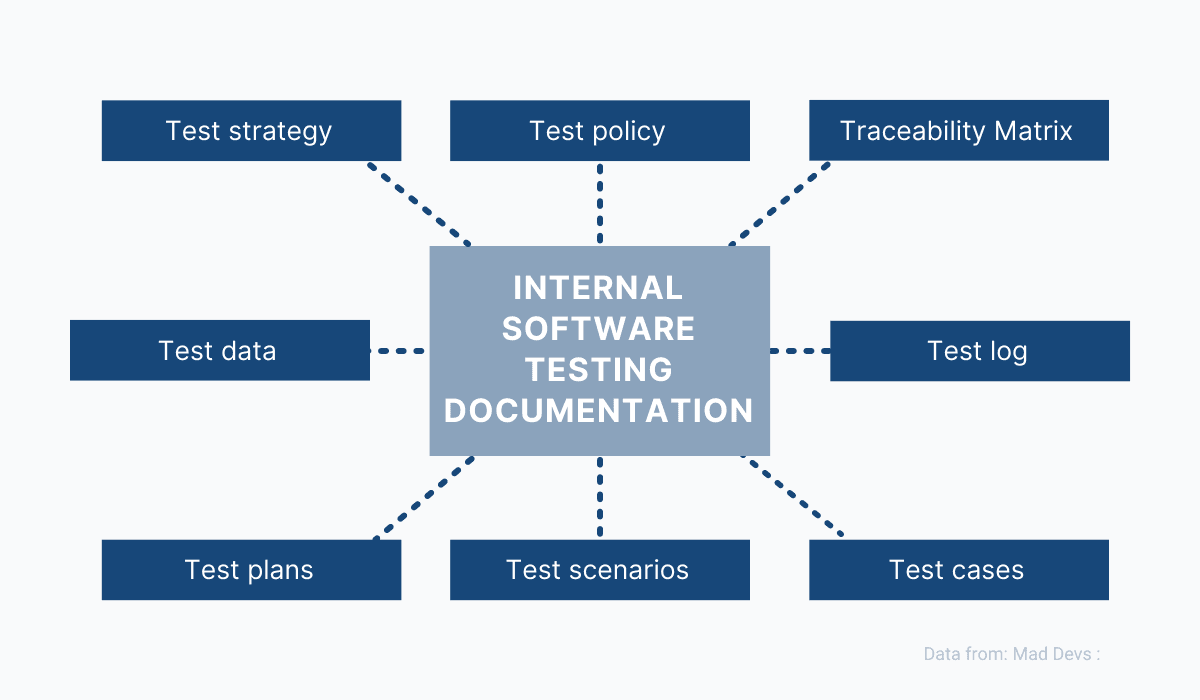
Source: Archbee.com
Let’s take a look at each of them.
-
Test policy stipulates any testing rules that need to be followed; for example, if testers can use private equipment or must only use corporate devices, etc.
-
Test strategy - high-level document outlining at which project levels testing be performed. As the project advances, managers use this to check if everything’s on track.
-
Test plan is the most comprehensive document, containing all essential information, such as the testing scope, approach, members, resources, and limitations. This is distributed to all team members.
-
Test scenarios classify the product’s interface and performance into modules. They ensure that all possible process flows are tested from start to finish.
-
Test cases describe the how of testing. They detail a set of conditions, inputs, and step-by-step guides. By comparing current resources with the desired outcome, they determine if everything is in order.
-
Test data lists the data testers implement when executing test cases, e.g., media content, generated users, statistics, and similar.
-
Test log lists different test cases and records test results, providing a detailed summary report.
-
Traceability matrix is a table of various test cases with their requirements. With this, testers can track progress from design to coding and vice versa.
Now that you know what kinds of internal testing documentation there are, let’s take a look at those that are more user-oriented.
External Testing Documentation
There are three main kinds of external testing documentation:
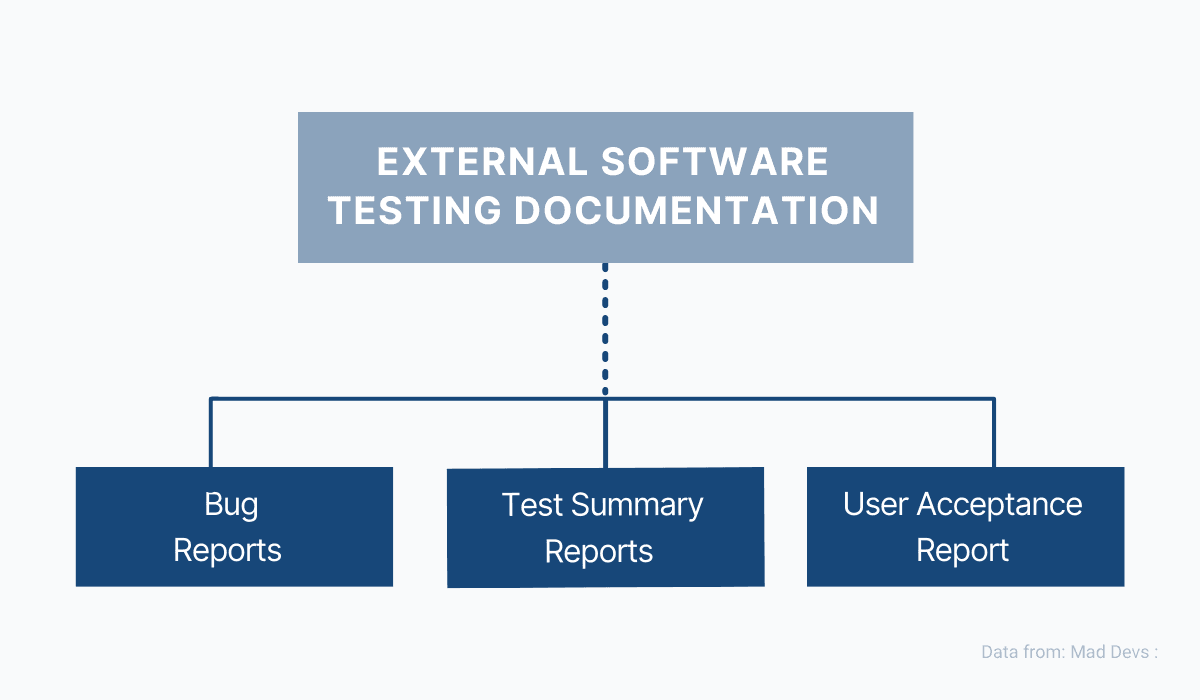
Source: Archbee.com
We’ll give you an overview of each of the three types.
- Bug reports communicate all information about bugs in the software, including a short description of the issue, severity reports, and priority classification. It should also explain the steps for recreating the bug, as well as provide a solution.
- Test summary reports summarize a test cycle’s findings. It often discloses the cost of locating errors, general testing efficiency, test suite efficiency, the amount of rework and authentication efforts, and similar.
- User acceptance report outlines the results of the software testing. This document is then handed over to stakeholders to ascertain that the developers’ and clients’ objectives are the same; to ensure they share an identical vision.
In other words, the report verifies that the technical specifications comply with the customers’ wishes.
Now let’s take a look at some ways to ensure that your test documentation brings value to the reader.
Tips to Achieve Great Test Documentation
There’s no point in doing anything by half; if your testing documentation isn’t well-executed, you may as well have not written it.
It’s only valuable to the QA and developer teams if adequately composed.
Make sure your testing documentation is high-quality, there are a few practices to stick to. They will ensure your documents are the best they could be.
Follow the tips below, and you’ll provide your co-workers with valuable and comprehensive software testing resources.
Maintain It
It’s not enough to write the documentation, file it, and never look at it again. Quite the contrary—testing documentation needs to be consistently updated.
This is because software testing is constantly changing. Requirements and priorities are often altered, which in turn influences resources, testing scope, and similar parameters.
Furthermore, if a new feature is added to the software, this should also be tested and recorded in the documentation.
If these edits aren’t reported, the documentation becomes out-of-date and irrelevant to the company. At that point, it’s no longer a reference point. Bertrand Meyer also pointed this out:
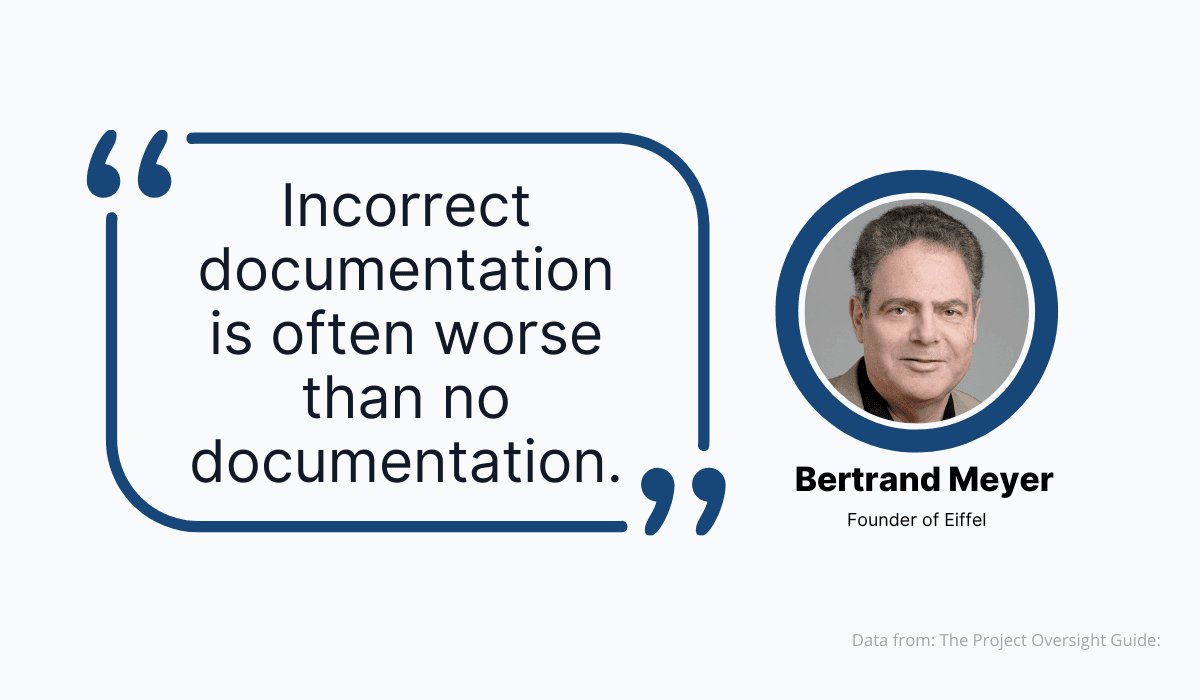
Source: Archbee.com
As such, it’s crucial to maintain the testing documentation, to ensure that it remains helpful and current.
One way to go about this is regular document verifications.
Archbee offers a feature where a particular team member receives automatic, recurring notifications to check up on a document’s content.
The employee can even be pinged as often as every week.
The video below shows how it works:
Source: Archbee on YouTube
By sending out these automatic updates, workers can routinely maintain the documentation, and your records will never go out of date.
Keep Everything In One Secure Place
Software testing documentation is only helpful to your colleagues if they can find it. When documents are scattered across multiple apps, you have a disorganized mess on your hands.
Instead, all testing documentation should be in one single, secure location. This makes it easy to find whatever you need, whenever you need it.
However, that location should not be in the public domain. It’s safer to administer some security, such as password protection, JWT authentication, or data encryption.
A documentation platform would fulfill both requirements. All your records would be hosted in a centralized environment, and employees wouldn’t waste any time searching.
Below is an example of a documentation platform, Archbee.
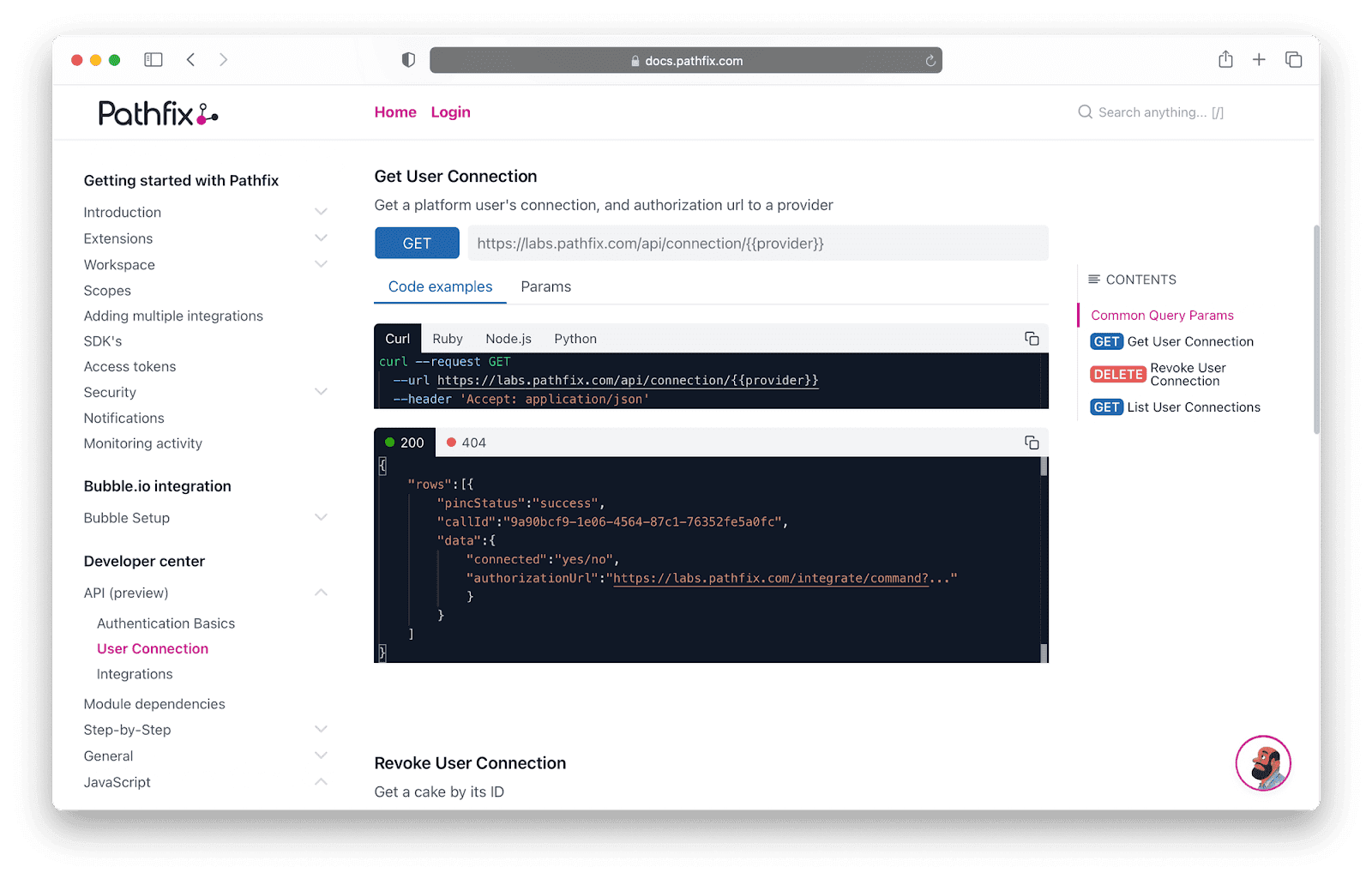
Source: Archbee.com
Archbee keeps all documents under the same roof, making navigation between documents extremely easy.
The platform is also secure. Archbee offers its users a variety of security options, among them JWT authentication.
For this measure, your developer team will create a JWT with a secret key you supply in Archbee’s UI.
This is then given back to Archbee as part of a link. You can see how it's done here:
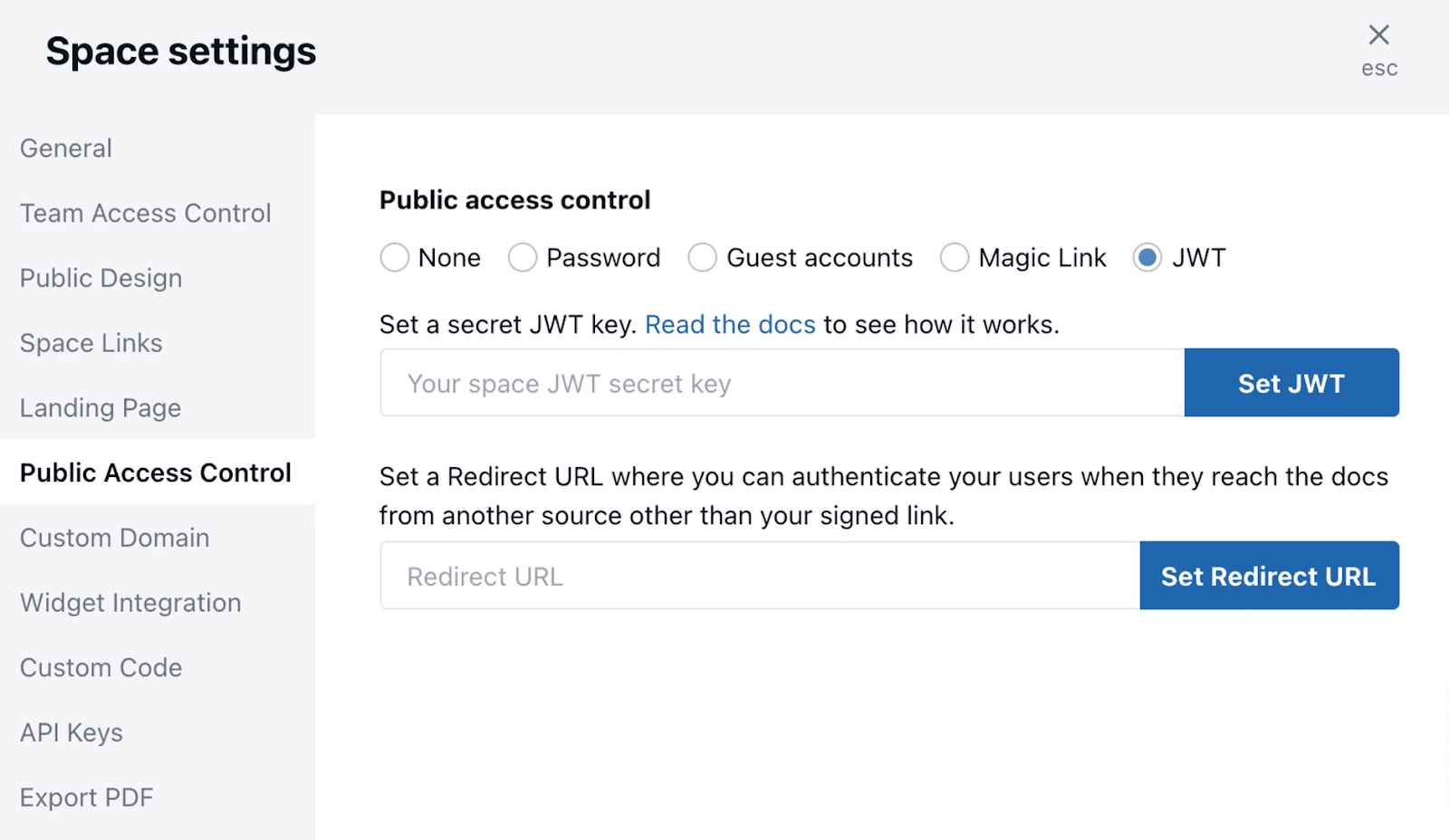
Source: docs.archbee.com
JWTs are a secure transfer of information, as they are digitally signed with a secret key.
Use Standardized Templates
When composing the testing documentation, it’s best to keep it simple. Unless a specific situation calls for it, there’s no need for fancy tools.
Instead, strive to utilize well-known applications like Word and Excel. This way, readers can easily access your documentation without installing additional software.
Furthermore, it’s recommended to follow one set template.
There’s no need to reinvent the wheel; once you’ve found a system that works for your organization, bookmark that document and use its outline as a template for future papers.
That way, you don’t waste time on formating.
If you’re unsure about how to start, there are also online resources you can download.
Here’s a Traceability Matrix template example:
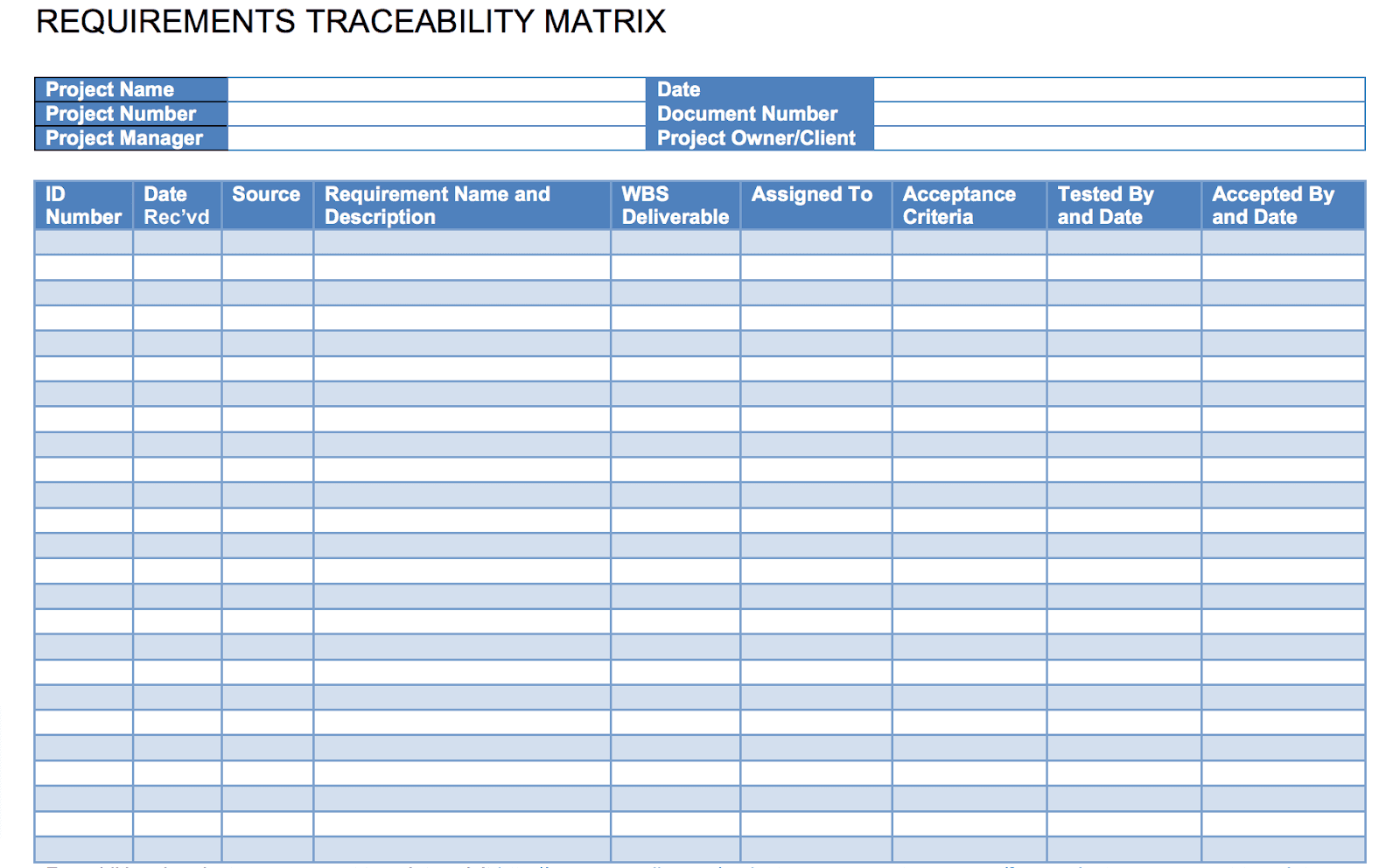
Source: My PM
This visual is a possible Traceability Matrix format you could use for your testing documentation.
Archbee also provides various ready-made templates for several departments, including Engineering.
They should facilitate composing your documentation, and the option to use one will appear whenever you add a new document.
Here’s an example of their Tech Specs template:
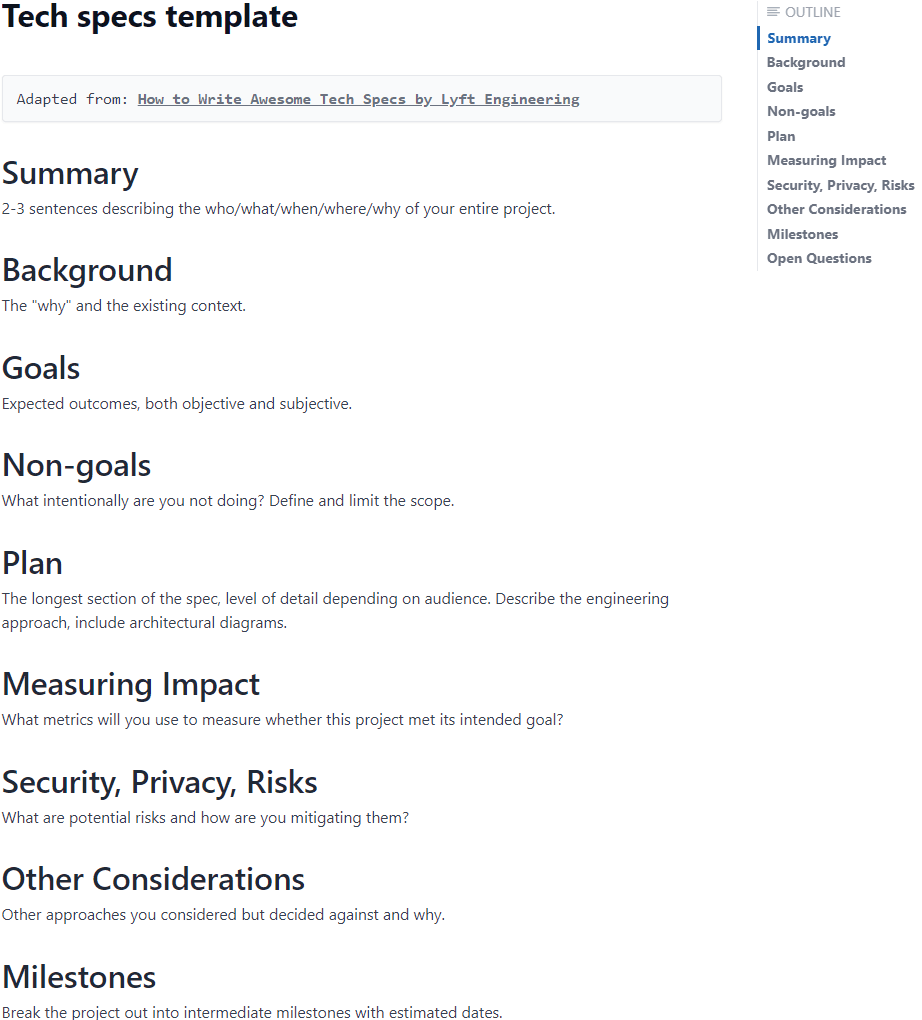
Source: docs.archbee.com
By adopting these templates, you won’t even have to leave your documentation platform to import the template format—it’s already offered within the platform.
Make It Detailed Enough
Above all, excellent software testing documentation should be highly detailed. Software is a multi-layered endeavor, and software testing is the same.
To have a comprehensive and transparent overview of all testing, it’s important to write detailed documentation.
For example, consider bug reports.
A one-line bug description isn’t adequate in testing documentation.
Readers want to understand the error fully; they expect a comparison between what is displayed and what should display.
Furthermore, the report must explain how to solve the problem, as a bug report without details on debugging isn’t worth much. Cem Kaner commented on this:

Source: Archbee.com
In other words, debugging often depends upon how detailed your document is.
The story is the same across all testing documentation; the more detailed the documents, the more guidance they provide, and the more work gets done.
A Reddit user offers his view on testing documentation:
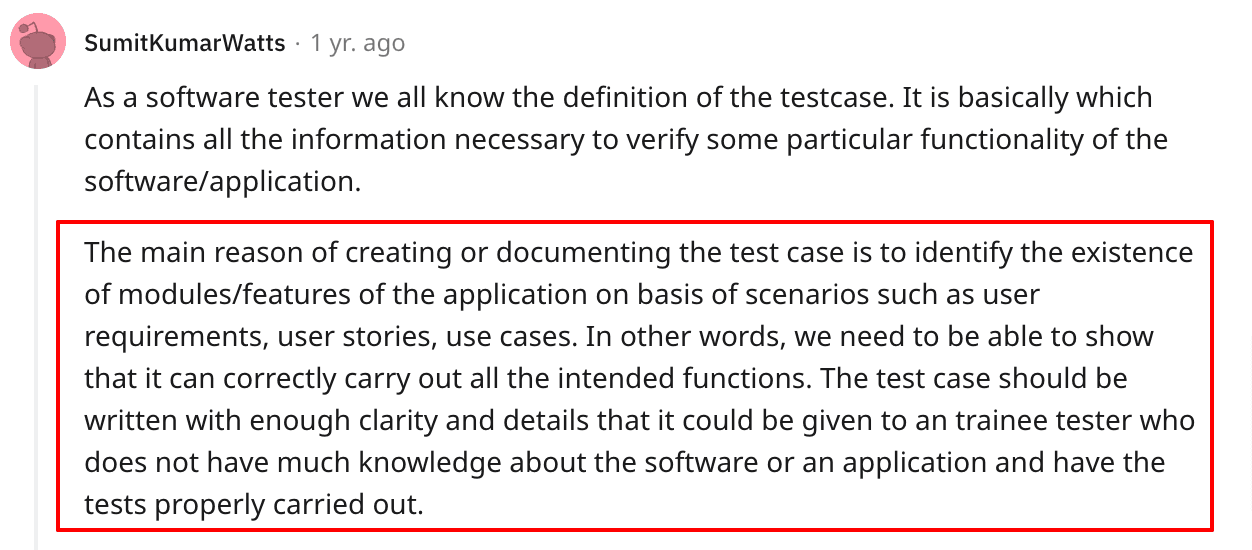
Source: Reddit
With detailed documentation, all other testing aspects are greatly facilitated.
Furthermore, if a document is very detailed, this also improves its searchability. If you’re looking for a specific section, it will be much easier to find that segment with exhaustive details.
For example, stipulating software editions and versions is already a huge help.
Conclusion
Software testing documentation records all relevant aspects connected to software testing; with this document, testers will have a reference point to fall back on.
There are multiple documentation types, but they can be broadly divided into internal and external documentation. This depends on the documents’ audience.
While writing, it’s a good idea to use a standardized template and to be extremely detailed. The documents should also be kept in one spot for easier organization, and updated regularly.
Testing documentation is invaluable for any organization, as it eases the testing process. We hope it will assist you with your testing procedures!
FAQ
Frequently Asked Questions
Software testing documentation is the complete written record of how you plan, run, and evaluate software tests. It captures the testing team’s policies, strategy, plans, scenarios, test cases, test data, logs, metrics, and results—created before, during, and after testing. Think of it as the single source of truth that explains what will be tested, why it matters, how it will be executed, and what outcomes were observed.



